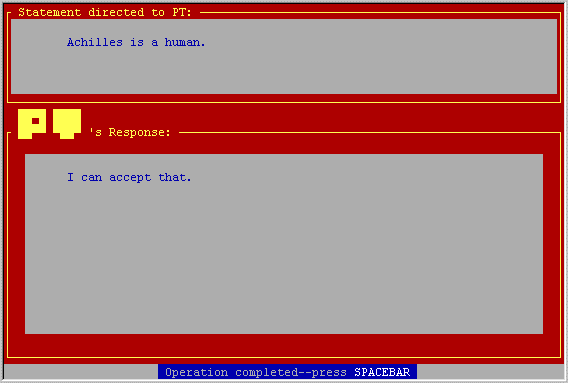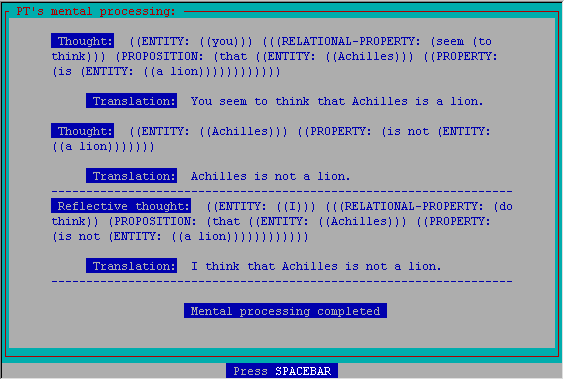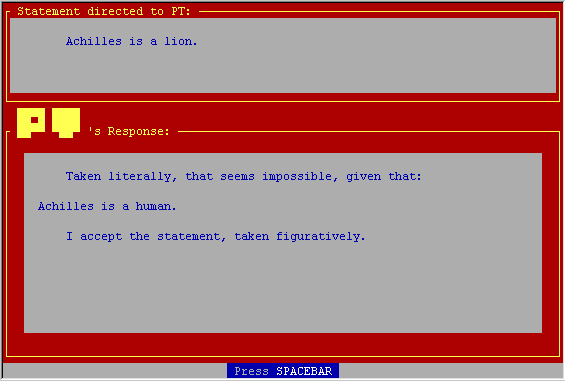Return to MODULE PAGE
Metaphor & Recognition
Clay Beckner: Author
PT assumes that propositions preceded by the explicit cues "It is as if" or "Metaphorically speaking" are metaphorical. But John Barker has also recently modeled a type of metaphor recognition with PT, so that PT volunteers to interpret certain types of sentences as metaphors. Let's consider a simple example of PT's current approach; a discussion of the theoretical context (and an extensive self-analysis) will follow.
For this example, we'll start by adding Anything that is a human necessarily is not a lion to PT's set of meaning relationships. This inference principle (admittedly, in a rather crude way) has the effect of setting up a rigid categorical border between humans and lions: humans are, by definition, excluded from the category of lions. Now we tell PT that Achilles is human, and PT accepts the statement:

Next we tell PT Achilles is a lion . The following screens show how PT processes this statement. Based on the meaning relationship we entered earlier, PT detects a contradiction:



Finally, PT responds that the statement Achilles is a lion must be metaphorical, and she adds It is as if Achilles is a lion to her set of beliefs.

PT's approach to metaphor-recognition is thus based on first identifying instances of categorical falsity (as modeled by the set of meaning relations). In this sense, PT's approach is reminiscent of Paul Grice's theory of conversational maxims.
A pragmatics approach
Paul Grice argues that the participants in a conversation implicitly agree on a "purpose or direction" for their conversation (161). This purpose may change throughout the conversation, yet at each moment there is some mutually recognized direction for the conversation. In Grice's model, each participant cooperates in an attempt to achieve that purpose; both speaker and listener typically assume that utterances are governed by four maxims:
Quantity:
Provide neither more nor less information than required.Quality:
Do not say what you believe to be false.Relation:
Only talk about things that are relevant to the conversation's purpose.Manner:
Avoid obscurity or ambiguity.
Grice claims that although speakers generally follow all four of the above, at times they will deliberately flout one or more maxims. When this happens, the listener must assume that the speaker's words implicate something other than their literal meaning. For instance, Grice cites tautologies as an example of a Quantity maxim violations. A statement such as "Women are women" conveys no information if taken literally, and thus implicates more than the words themselves (166). A different type of Quantity maxim violation would be "Miss X produced a series of sounds that corresponded closely with the score of 'Home Sweet Home'" (168). Here, the speaker has provided too much detail, and thus means something other than the actual words.
Metaphor vs. Irony
So how can metaphors be identified using Grice's theory of implicature? Metaphorical propositions generally appear to be false if taken literally, and thus human or AI listeners might hope to single out metaphors as violations of Grice's Quality maxim. But there's a complication. Metaphors must be distinguished not just from literal statements, but also from non-metaphorical Quality maxim violations, including irony. For Grice, an ironic statement is one that implicates the negation of the statement's apparent meaning. He proposes the following means of distinguishing metaphors from such ironic statements:
Examples [of metaphor] like 'You are the cream in my coffee' characteristically involve categorical falsity, so the contradictory of what the speaker has made as if to say will, strictly speaking, be a truism; so it cannot be that that such a speaker is trying to get across. The most likely supposition is that the speaker is attributing to his audience some feature or features in respect of which the audience resembles (more or less fancifully) the mentioned substance (166).
Let's leave aside for now Grice's problematic assumption that metaphors are "fanciful resemblances," in order to focus on his approach to recognizing metaphors. Of course, PT's search for categorical contradictions is roughly modeled on the distinctions Grice makes here. But so far, PT has no means of identifying ironic propositions, and it is difficult to see how to fully implement a model of Grice's theory. For Grice, a metaphor is apparently a Quality maxim violation whose negation does not constitute a Quantity maxim violation (!). Grice's theory seems to suggest a linear, algorithmic approach to metaphor recognition, which would have to look something like this:
(Input) Proposition P: X is Y
- Does P violate the Quality maxim? If not, P is literal. If yes, continue.
- Does not-P violate the Quantity maxim? If not, P is ironic. If yes, continue.
- P is metaphorical. Seek a resemblance between X and Y.
Are metaphors anomalous?
The fact that the hypothetical algorithm on the previous page is linear is in itself perhaps problematic. We might note, first of all, that a unidirectional, linear algorithm separates the process of metaphor recognition from metaphor interpretation. Are they really separate processes? For instance, try to imagine an AI program that always identifies metaphors correctly (perhaps giving an answer of "Yes, this passage is metaphorical," "No, this passage is not metaphorical," or "More context needed to decide") but which cannot arrive at a meaning for these texts. Such a program seems impossible, as some of the examples I'll discuss should illustrate.
George Lakoff, too, would object to the notion that "we look first for the literal meaning of a sentence. . . and seek a metaphorical meaning only as a fallback, if we are not content with the primary literal meaning" (125). Lakoff argues that such an approach reinforces the false claim that metaphorical language is deviant and secondary to literal language. He shows, in contrast, that our conventional language in many domains is metaphorical; our understanding of certain domains (such as death and time) is primarily metaphorical.
A linear metaphor recognition algorithm may also be insufficient because not all metaphorical utterances violate the Quality maxim. Some metaphors can certainly be recognized as categorical falsities when taken literally: "You are the cream in my coffee," "Achilles is a lion," "Electrons love protons." But many propositions are purely literal in one setting, and metaphorical in another. A Gricean recognition algorithm like the one above might find a literal interpretation of such a metaphor satisfactory, and will stop before reaching the correct interpretation. Consider, for instance, "Smith is a plumber." This sentence involves no categorical falsities and could very well be used literally. But if used in a context where both speaker and listener know that Smith is an inept surgeon, the sentence would be a metaphor (Kittay 100). A sentence can even be true literally and metaphorically at the same time, as in "That painting is blue," where the painting is both blue and sad (Kittay 77) . John Haugeland discusses the apparently non-anomalous metaphor in "Though her blouse draped stylishly, her pants seemed painted on":
Most approaches to metaphor. . . assume that metaphorical readings aren't attempted unless there is something "anomalous" about the "literal" reading (as in "He is the cream on my peaches," or ". . . faster than greased lightning"). But in this case there is nothing anomalous about pants with paint on them-they would even clash with "stylish," explaining the conjunction "Though. . ." On that reading, however, the sentence would be silly, whereas the metaphor is so apt that most people don't even notice the alternative.(625)
Here, we should note that the fact that "most people don't even notice the alternative" to the metaphor does not constitute proof that they have not considered the alternative (or that they did not, at some point in the past, have to consider alternatives to this highly conventional metaphor). Grice's maxims might not seem to match our experiences as readers and listeners; we don't consciously apply such a rigid set of rules to text or speech, because we usually just "see" the right interpretation. But the fact that we're not consciously aware of using Grice's rules (or something similar to them) doesn't necessarily mean that we're not using them on some level. That is, the conscious mind does not always have access to its own workings, so that a computer model of human linguistic ability might still require the use of rules similar to Grice's.
In many ways, though, it does seem that Haugeland is probably correct. For instance, the speed with which natural language speakers select the correct interpretation for an utterance would seem impossible using an "anomaly-identifying" algorithm like the one described above. If Haugeland and Lakoff are right, and metaphor recognition does not require us to attempt an anomalous literal reading first, the question is, how do we interpret speech? Do we consider all possible interpretations (literal, sarcastic, metaphorical) simultaneously and instantaneously pick the best one? It might be that a Gricean algorithm like the one above is inherently limited by a linear, symbol-processing approach to language--which also means that PT could best model human linguistic abilities if augmented by a PDP approach.
Violation of Conceptual Categories vs. Violation of Beliefs
There is yet another complication hidden within Grice's theory of maxims, which is dramatized by PT's current approach. PT cannot distinguish between metaphorical input and input that merely conflicts with her existing beliefs. Presumably, we don't always want PT to think we're speaking metaphorically when we tell her things that violate her most deeply-held beliefs (that is, her set of meaning relationships). At times, we'd rather have her consider the evidence we present, even if she for the moment, believes us to be wrong. Suppose that, for the sake of illustration, we program PT with a rigid, sexist view of the world. The following categorizing propositions are added to PT's meaning relationships:
- Anything that is a doctor necessarily is a man.
- Anything that is a man necessarily is not a woman.
- Anything that is a woman necessarily is not a man.
Now we tell PT, Smith is a doctor, and ask, Can you deduce anything new? Since PT believes that all doctors are men, she naturally concludes, Smith is a man. Now suppose we input Smith is a woman, and then watch the cognitive processing that results. First, PT deduces that Smith is not a woman, based on the inference principle Anything that is a man necessarily is not a woman. From there, the cognitive processing continues: You seem to think that Smith is a woman. Smith is not a woman.
PT emerges from cognitive processing, and finally responds: Taken literally, that seems impossible, given that Smith is a man. I accept the statement, taken figuratively. PT then adds It is as if Smith is a woman to her set of beliefs.
What could It is as if Smith is a woman possibly mean? It doesn't seem like anything a human speaker would conclude. Are there any analogous behaviors among humans? What happens in metaphor recognition when a speaker and listener have very different beliefs about what is true and false?




